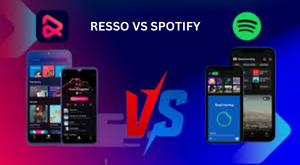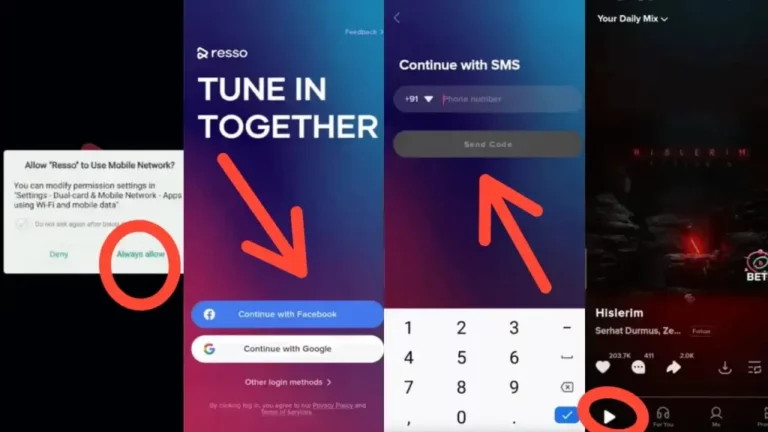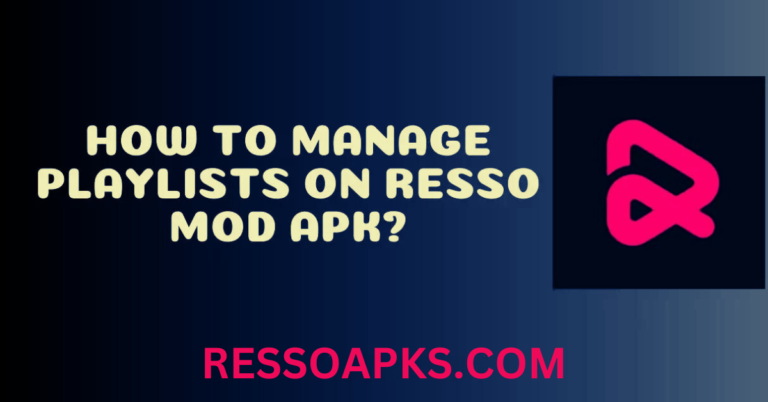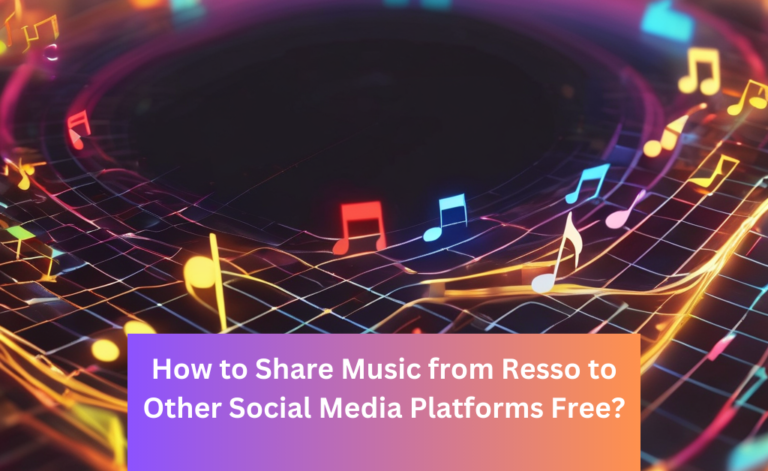Resso vs Spotify Which is Best?
In the dynamic landscape of music streaming services, a compelling competition unfolds between(Resso vs Spotify) two prominent contenders: Resso and Spotify. Both platforms have indelibly altered the music consumption paradigm, providing users unparalleled access to extensive music libraries, tailored playlists, and inventive functionalities.
As these services primarily provide soundscapes for diverse life moments, examining Resso and Spotify meticulously becomes essential. This examination is critical for identifying the distinguishing elements and exclusive features that resonate with the choices of a worldwide user base.
Resso
Resso is a music streaming platform by ByteDance that offers an interactive experience for discovering, listening to, and engaging with music. It includes social features for sharing content related to songs, enhancing the music listening experience.

Spotify
Spotify is an apparent music real-time feature, delivering a broad assortment of melodies, collections, and digital recordings. Clients can pick among free and premium memberships, licensing on the web and disconnected music tuning in, customized playlist creation, calculation-driven music revelation, and investigating different kinds and specialists.

Key Features and Differences between Resso vs Spotify
Certainly, there are more differences between Spotify and Resso:
Music Content and Libraries:
Spotify: It boasts a massive catalog of songs, albums, and podcasts, covering a wide range of genres and languages, making it a go-to platform for diverse musical tastes.
Resso: Offers a growing collection of music with a focus on integrating social elements and user-generated content, creating a more engaging music exploration.
User engagement and interaction:
Spotify: Provides the option to follow artists, friends, and public playlists, allowing users to see what others are listening to and share their musical preferences.
Resso: Places a stronger emphasis on user interaction, enabling comments on specific song lyrics and the ability to add images and text to songs.

Personalization Approach:
Spotify: Relying on algorithms, Spotify tailors personalized playlists and song recommendations based on user listening history and preferences.
Resso: Curates mood-based playlists and encourages user-driven content creation, adding a personal touch to the music experience.
Community and social networking:
Spotify: Offers a sense of connection through shared playlists, collaborative creations, and the ability to see what friends and influencers enjoy.
Resso: Enhances the social aspect by integrating comments, enabling users to engage with each other and the music on a deeper level.
Visual Storytelling:
Spotify: Primarily focuses on the auditory aspect of music, offering album covers but not delving extensively into visual storytelling.
Resso: Elevates the experience by incorporating visuals, including album art and synchronized lyrics, adding depth and emotion to the music.
Ease of Use and Familiarity:
Spotify: Is known for its intuitive and straightforward interface, catering to users who prefer a traditional and easy-to-navigate setup.
Resso: Offers a unique and visually immersive interface that might take some getting used to, especially for those new to interactive music platforms.
Music Sharing Approach:
Spotify: Allows users to share music with friends and on social media, fostering music discovery through shared playlists and tracks.
Resso: Encourages deeper engagement through user-generated content and visual sharing, making sharing music a more creative endeavor.
Podcasts and non-music content:
Spotify: Diversifies content with a vast selection of podcasts, catering to users interested in educational, entertainment, and informational audio content.
Resso: Primarily focuses on music and the interactive music experience, with a lesser emphasis on non-music content like podcasts.
These nuanced differences contribute to the distinct identities of Spotify and Resso, appealing to various preferences in music streaming and social engagement.
Read: How to Login In Resso App?
Using Resso
- Download and install: Start downloading the Resso app from our website, ressoapks.com. Install the app and open it.
- Sign Up or Log In: If you’re new to Resso, sign up for an account using your email, phone number, or social media accounts. If you already have an account, log in.
- Explore the Home Screen: You’ll land on the home screen upon logging in. You’ll find recommended playlists, recently played songs, and trending tracks here. Scroll and explore to discover music.
- Search for Music: Tap on the search icon (usually a magnifying glass) and enter the name of a song, artist, album, or genre you’re interested in. Resso will present you with relevant results.
- Play Music: When you find a song you want to listen to, tap on it. The song’s page will open, displaying its album art, lyrics (if available), and options like play, pause, and skip.
- Create Playlists: Find a song you want to add and tap the “+” icon to create a playlist. You can create new playlists or add to existing ones. Name your playlist and customize its settings.
- Engage with Lyrics and Comments: Many songs on Resso come with synchronized lyrics. You can tap on a line of lyrics to start playback from that point. You can also leave comments on specific lyrics to interact with other users.
- Share and Connect: Resso encourages social interaction. You can share songs, albums, or playlists with friends via messaging apps or social media platforms.
Using Spotify
- Download and Install: Start downloading the Spotify app from our website, ressoapks.com. Once downloaded, install the app and open it.
- Sign Up or Log In: If you’re new to Spotify, sign up for an account using your email address or Facebook account. If you already have an account, log in.
- Explore the Home Screen: You’ll land on the home screen upon logging in. You’ll find recommended playlists, recently played music, and featured content here. Scroll to discover music.
- Search for music: Tap on the search icon (usually a magnifying glass) and enter the name of a song, artist, album, or genre you’re interested in. Spotify will display relevant results.
- Play Music: When you find a song you want to listen to, tap on it. The song’s page will open, showing its album art, playback controls (play, pause, skip), and more.
- Create Playlists: To create a playlist, go to “Your Library,” tap on “Playlists,” then tap the “+” icon. Name your playlist and start adding songs.
- Explore Radio and Podcasts: Navigate to “Radio” for genre-based radio stations, or check out podcasts under the “Podcasts” section.
Resso Pros and Cons
Pros:
Interactive Music Experience: Resso offers a unique blend of music and social interaction, allowing users to engage with lyrics, comment on specific lines, and connect with others over shared musical interests.
Visual Enhancements: Integrating visual elements, such as album artwork and synchronized lyrics, adds a new layer of immersion to the music-listening process.
Personalized Playlists: Resso’s mood-based playlists and personalized recommendations help users discover new songs that match their emotions or preferences.
User-Generated Content: Resso empowers users to contribute by allowing them to add images and text to their favorite songs, making the music-sharing experience more expressive.
Social Sharing: Sharing music, playlists, and comments with friends creates a sense of community and allows for a deeper connection over shared musical tastes.
Community Interaction: Collaborative playlists encourage users to build collections, fostering a collaborative and communal approach to music curation.
Cons:
Limited Geographic Availability: Resso may not be available in all regions, limiting its accessibility to users in certain countries.
Content Library: While Resso’s library is growing, it might not be as extensive as some other music streaming platforms, potentially leading to gaps in content availability.
Learning Curve: The interactive features of Resso might take some time for users to get used to, which could be a learning curve for those accustomed to more traditional music streaming interfaces.
Advertising Interruptions: Users of the free version might experience advertisements while listening to music, which can disrupt the immersive experience.
Social Pressure: For some users, the social interaction features might feel intrusive or pressure them to engage with comments and sharing, even if they prefer a more private listening experience.
Data Usage: The interactive nature of Resso might result in higher data usage, especially for users who frequently engage with comments, images, and other interactive features.
Spotify Pros and Cons
Pros:
Vast Music Library: Spotify boasts an extensive and diverse collection of songs, albums, and genres, ensuring there’s something for every musical taste.
Personalized Recommendations: Spotify’s algorithms curate personalized playlists like “Discover Weekly” and “Daily Mixes,” introducing users to new music that aligns with their preferences.
Offline Listening: With a Spotify Premium subscription, users can download their favorite songs, albums, and playlists for offline listening, perfect for when an internet connection isn’t available.
Cross-Platform Compatibility: Spotify seamlessly syncs across devices, allowing users to start listening on one device and seamlessly continue on another, ensuring a consistent and uninterrupted music experience.
Cons:
Advertisements in the Free Version: Spotify’s free-tier users encounter intermittent advertisements during their music sessions, disrupting the flow and immersive experience.
Limited Offline Listening: While Spotify Premium offers offline listening, there might be restrictions on the number of tracks that can be downloaded for offline enjoyment.
Algorithmic Overwhelm: The algorithmic recommendations, while beneficial, can sometimes flood users with choices, potentially making it difficult to maintain a sense of control over their music journey.
Audio Quality Constraints: The audio quality in Spotify’s free version might be lower than in the Premium version, which could be a drawback for those who prioritize excellent sound reproduction.
FAQs Resso vs Spotify
Conclusion
In conclusion, the world of music streaming is ever-evolving, and the choice between Resso and Spotify is just one part of the diverse musical landscape. Embrace the options available and let the music play on.
If you have any specific sections or topics you’d like to explore further or need any additional information, feel free to let me know!







